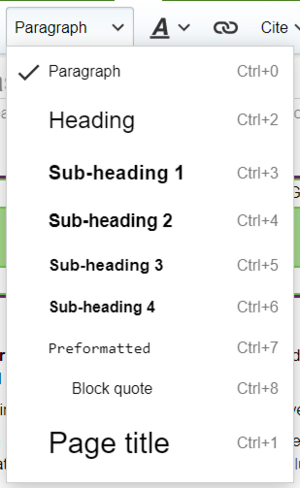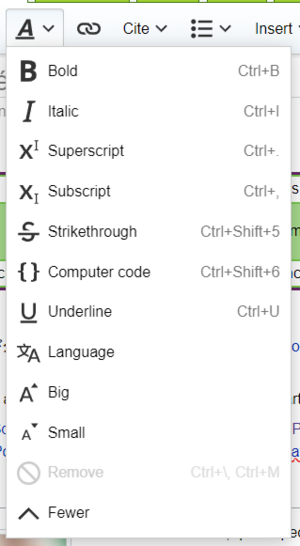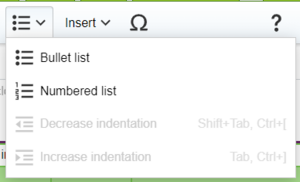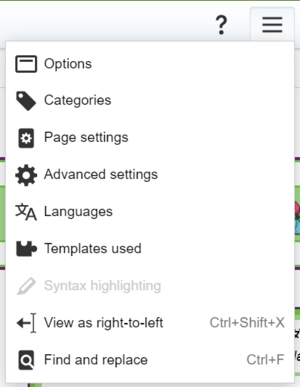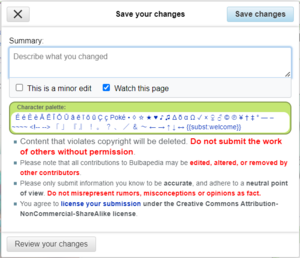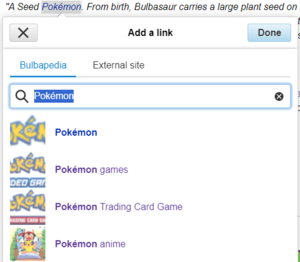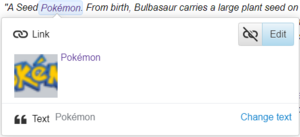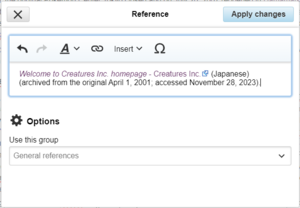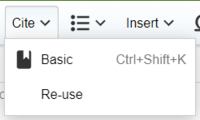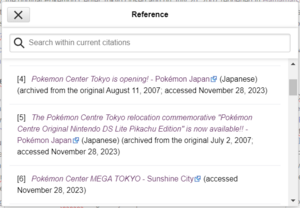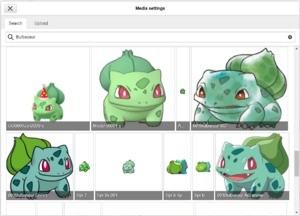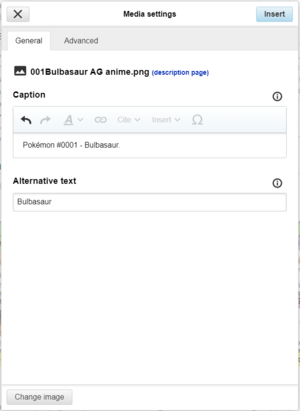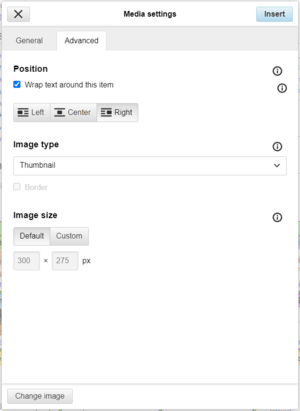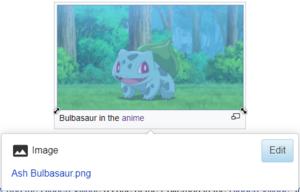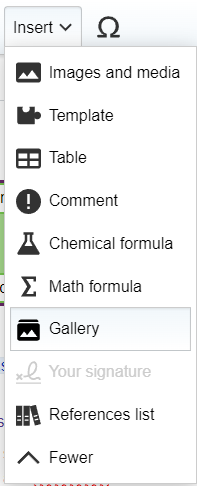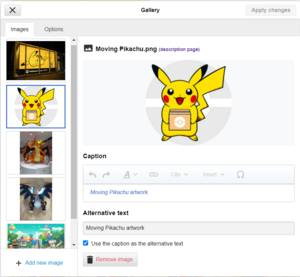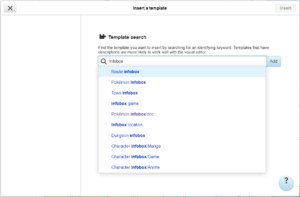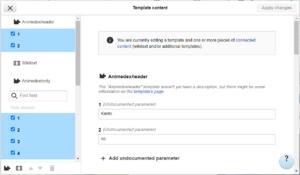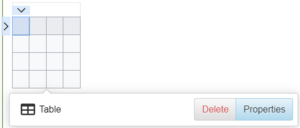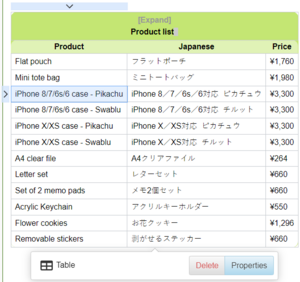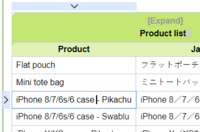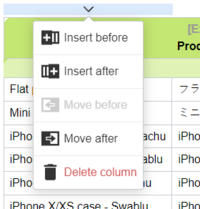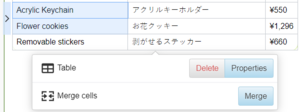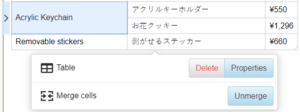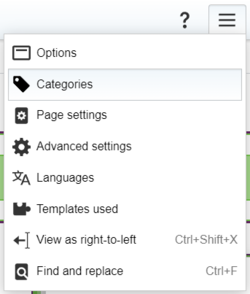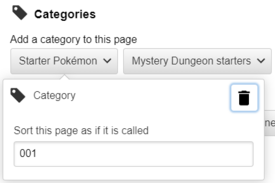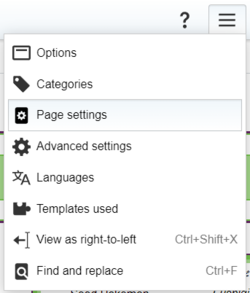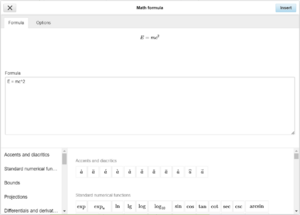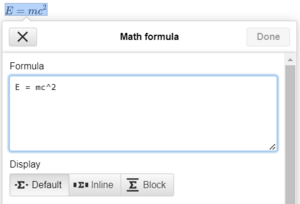Help:VisualEditor
VisualEditor gives you the ability to edit without needing to learn simple wikicode markup, as is required by the default Source Editor. The VisualEditor is distinct in that it displays the text being edited almost as if it were already published. This guide gives illustrated, step-by-step instructions on the editor's features.
Opening the VisualEditor
| To edit a page using the VisualEditor, click on the "edit" tab at the top of the page.
It may take a few seconds for the page to open for editing, and longer if the page is very long. Clicking on the "edit source" tab will open the classic wikicode Source Editor. |
|
| You can also open the VisualEditor by clicking on the "edit" link on each section. | |
| Currently, VisualEditor is only available in the "Main", "User" and "Category" namespaces (along with the "File" namespace on the Bulbagarden Archives). In other namespaces, only the Source Editor can be used. | |
Getting started: the VisualEditor's toolbar
| The VisualEditor's toolbar appears at the top of the screen when you begin editing. It includes some familiar icons: | |
| Undo and redo the changes you have made. | |
| Headings pull-down menu: allows you to change how the paragraph is formatted. To change the style of a paragraph, put your cursor in the paragraph and select an item in this menu (you don't have to highlight any text). Section titles are formatted "Heading", and subsections are "Sub-heading 1", "Sub-heading 2", and so on. The normal format for text is "Paragraph". | |
Formatting: clicking the "A" opens a menu.
If you have not selected any text, then when you click the "A" to open the menu, and then select an item, that formatting will apply to the text that you start typing, from wherever your cursor is located. | |
| Linking tool: The chain icon is the linking tool. Clicking on it (usually after selecting some text) opens the link dialog. | |
| Cite menu: The "cite" menu is used to add inline citations (also called "references"). | |
| Lists and indentation: The first two items allow you to format text as either a "Bullet list" or a "Numbered list". The last two items allow you to decrease or increase the indentation level of list items. | |
Insert: The "Insert" menu allows you to insert different objects into the page:
| |
| Special character insertion: The "Special character" (Ω) icon is next to the "Insert" menu. When clicked, it displays a dialog showing many special characters. By clicking on a specific character, you place it into the text. These special characters include some standard symbols, diacritics, and mathematical symbols. | |
| The Edit notices button displays any notices for the page (and will not appear if there are none). | |
The Page options menu is to the left of the Save changes button and the Switch editor menu. On this menu there is a button to open an Options dialog with the following (left side) tabs:
The tabs of the Options dialog are also displayed in the Page options menu and can be opened by clicking on them. Furthermore the Page options menu contains the items Syntax highlighting (which is only available when using the VisualEditor in "wikitext mode"), View as right-to-left, and the item Find and replace, which opens a bar, where you can insert words or regular expressions you are searching for and those to replace them with, together with several buttons for options. | |
| The Switch editor button is next to the Save changes… button. It allows you to switch to the wikicode Source Editor. | |
Publishing changes
| When you are finished editing, click the "Save changes…" button in the toolbar. If you have made no changes, the button will be disabled (grayed out). To cancel all your editing changes, close your browser tab, or click the "article" tab above the edit toolbar. | |
| Clicking the blue "Save changes…" button opens a dialog. You can then enter a brief summary of your actions, mark your edit as minor, and add the page to your watchlist. The box for the summary is the equivalent of the Summary: field in the wikicode Source Editor.
You can also review your changes using the "Review your changes" button to confirm that they will function as intended before saving your changes. This is similar to the "Show changes" button in the wikicode Source Editor. The "Resume editing" button (×) returns you to the page you were editing. You can publish all of your changes later. |
|
Editing links
| Links can be added through the "Link" icon (links in a chain) in the toolbar, or by using the shortcut "Ctrl+K" (or "⌘+K" on a Mac).
If you select (highlight) text and then click the "Link" button, that text will be used in creating the link. For a link that involves only one word, you can either select that word or just put the cursor within that word. | |
| When you use either the button or the shortcut, a dialog will open in which you may type the link.
The link tool will try to help with internal links by searching for likely matches. Once you have entered or selected the link, you complete the linking process by pressing Enter on your keyboard or by clicking the "Done" button. Your link will immediately appear on the page, but as with other changes to the page, it will not be published until you publish the entire page. | |
| To link to a web page on another website, the process is similar: Choose the "External site" tab, and enter a URL in the box. | |
| External links without labels look like this: [1]. You can add these by placing your cursor away from any word (e.g., after a space). Open the link tool by clicking on the button or clicking the shortcut keys. Type the URL in the box, and click the "Done" button to insert the link. | |
| To change or remove an existing link, click within the text for that link, then click the "Link" icon that appears near it. The dialog will appear, for editing. You can also get to the dialog with the "Ctrl+K" keyboard shortcut. When a link is selected, it appears as blue framed.
In the link editing dialog, you can then change where the link goes. You can also remove the link entirely by clicking the "Remove" button in the upper right corner of the dialog. You can also open the link's target in another window by clicking on the copy of the link in the dialog box. (You might want do this to check if an external link is valid.) If you want to exit the link label (the text displayed as a link) or continue to write after this link, you can press "→" on your keyboard:
To edit the link label of an existing link, click within the link label and type the new one. But if you want to replace the entire label, please note:
| |
Editing references
Editing an existing reference | |
| To edit an existing reference, click on it where it appears in the text (usually as a bracketed number). clicking on the "Edit" button will open a dialog where you can edit the reference. | |
| Clicking "Edit" opens the reference dialog. Here you can create the reference. See Help:References for more information.
Click on "Apply changes" when you are done. |
|
Re-using an existing reference | |
| If the page already contains a citation that applies to the text you want to source, then you can choose to re-use that existing citation.
To re-use an existing reference, place your cursor in the body of the text where you want to add a new reference (number) for that citation. Then click on the "Re-use" item from the "Cite" menu. |
|
| In the Reference dialog, look at the list for the reference you want to reuse, and select it. If there are many references, you can use the search box (labelled "Search within current citations") to list only those references that include certain text. | |
Adding a new reference | |
| To add a citation using the "Cite" menu, place your cursor where you want to add it in the text. Then click "Basic". | |
| Shown here is what you will see if you select the basic references item. In the Reference editor, you can add your citation, including formatting.
You can make the reference belong to a given group, although normally this is left blank. (This option is used to display groups of references with the "References list" tool.) |
|
| If there isn't already a list of references on the page (for example, if you are adding the first reference for the page), you need to specify where the list of references, and their text, will be displayed to the reader.
Place the cursor where you want to display the references list (usually at the bottom of the page), open the "Insert" menu and click the "References list" icon (three books). |
|
| If you are using several groups of references, which is relatively rare, you can specify the group in this dialog. Only the references that belong to that group will be displayed on the page at the location where you are placing the group.
The final step in the References list dialog is to click "Apply changes". |
|
Editing images and other media files
Editing images | |
| To add a new image (or another type of media file) to the page, click the "Images and media" icon (a picture of mountains) in the "Insert" menu. The image will be added wherever your cursor is. | |
| Clicking the "Images and media" icon opens a dialog that automatically searches the Archives for media files related to the title of the page you are editing.
You can change the search by changing the text in the dialog's search box. To choose a file, click on its thumbnail image. This places the image onto the page you are editing. | |
| After the image you selected is inserted into the page, another dialog will open. This dialog allows you to add and edit the caption of the image. The caption can contain formatting and links.
The media dialog also allows you to add alternative text captions, to help users who use screen readers, or who have disabled image display. | |
| You can also set various parameters for the image in the "Advanced" tab. These include the alignment, the type, and size of the image. | |
| When you are done, click "Insert" to close the dialog and return to editing the page. | |
| For an existing image, you can add or edit a caption or other settings by clicking on the image, then clicking on the "Edit" button that appears below the picture.
You can resize an existing image by clicking on it, then moving the resize icon (the two-headed arrow on one or both bottom corners). You can also drag and drop an image to a place higher or lower on the page. | |
Uploading images | |
Editing media galleries | |
| To add a new gallery, click the "Gallery" icon (a set of photos) on the "Insert" menu. | |
| To edit an existing gallery in the VisualEditor, click that gallery. Then, near the top of the gallery, click the "Edit" button. This brings up the gallery editor, with the full list of images included in the gallery. | |
| The gallery editor has two tabs, one to add images and their captions, the other controls display options.
The order of images can be rearranged by dragging the images on the left, and can be added using the "Add new image" button at the bottom of the list. The options tab allows size and layout to be edited. The default display options are preferred in most cases. When you click the "Apply changes" button, you will exit the gallery editor. You should then see your changes, with the gallery as it will now appear to readers. Remember that exiting the gallery editor does not save your changes. As with other changes made using VisualEditor, you must "Save" the entire page in order to save your work and make it viewable online. | |
Editing templates
| The powerful MediaWiki template system lets you insert dynamic content, text from other pages, and much more. For a detailed explanation and examples, see Help:Templates.
In the VisualEditor you can search for a relevant template, add a transclusion on the page you’re editing and, if needed, add custom content using parameters. | |
Insert new template | |
To add a template to a page, place your cursor at the position on the page where you want the template to be inserted. Then open the Insert menu and select "Template". Alternatively, type two curly brackets ({{) to open the same dialog.
|
|
| Find the template you want to insert by typing either its name or a relevant keyword. Results containing the search term in either the name or description will display in a dropdown. This should help you find a relevant template, even if you don’t know its exact name.
If you’re having trouble finding the kind of template you want by using keywords, you can look on other wiki pages with similar content and view or edit the page source to see which templates are in use. When you find the desired template’s name, you can type it into this field to insert it here. |
|
| You can also edit a template that’s already on a page. When you select the template you want to edit, it turns blue, and a box appears displaying "Template". Then select the "Edit" link or double click on the template itself to open the template editor. | |
| Some templates are not visible to someone reading a page. In the VisualEditor, such hidden templates are still shown so that you can click and edit or delete them. The name of the template will be shown next to the puzzle icon and both will be grayed out. | |
Template parameters | |
| You’ll see this dialog box when you’re adding a new template or editing one already in place. Click the link to the "template's page". There you can learn how to correctly employ and work with all of the template’s parameters. This includes learning the exact names of the parameters as written by the template author.
If you find in the documentation that the template expects parameters without names, fill in numbers as placeholders for the parameter names using the undocumented parameter input, then add text to the values you want to provide as you normally would. Example:
If you accidentally include nonexistent, misspelled or erroneous parameters, the values you enter for those parameters won’t show up on the page you’re editing. |
|
Editing multi-part template content | |
| During editing, you may open template content consisting of multiple templates or a single template linked to some wikitext. This differs from the nested templates described below. In this case, the templates are better visualized as being stacked or connected.
This content often contains “unbalanced templates,” templates which are incomplete on their own and need to be paired with some wikicode or another template in order to function. These related pieces of template content must be created in wikicode, but can be edited in the VisualEditor. In these cases you will see a notice at the top of the dialog to signal the situation and a specialized toolbar will be visible at the bottom of the sidebar. There you can use the icon buttons to add additional templates, additional wikicode, delete elements or change their order. |
|
Nested templates | |
Templates can include other templates as the value for parameters. You’ll recognize it when you see a parameter whose value contains the double curly braces ({{ }}) denoting a template.
The VisualEditor can’t present this template within a template (a nested template) using the editor’s easy-to-use interface, so if you want to nest a template yourself, you’ll need to understand how to add the template by hand in wikicode into the appropriate parameter field. |
|
Completing your edit | |
| When you have finished editing a template, you can click "Apply changes". Then you can preview your edit and make sure it looks the way you want and expect.
You may also see an error message; you may need to consult the template’s own documentation to get to the bottom of some errors. If you’re still having trouble, consider posting about your problem on the template’s talk page. |
|
Removing a template | |
| To remove a template in the VisualEditor, click the template. Press the "Delete" or "Backspace" key on your keyboard. The template will disappear from the page. | |
Editing lists
| You can use the VisualEditor to create lists, or to change the format of an existing list. There are two types of lists: unordered (bullet) and ordered (numbered).
To start a new list, just click on one of the two menu items shown here. Or, if you already have typed the list (on separate lines), select (highlight) the list you have typed, then click on one of the menu items. If you want to change the indentation level of part of an existing list, select the part of the list that you want to change. Then use the menu, or press the Tab key. (The Tab key increases indentation; use the shift key plus the Tab key to decrease indentation). You can even mix ordered (numbered) and unordered (bullet) lists, if the list items have different indentations. |
Editing tables
| You can use the VisualEditor to insert and change tables.
You can even import a table by dragging a comma-separated value (.csv) file from your computer into the main editing window. | |
| When you click on "Table", in the "Insert" menu, the VisualEditor inserts a blank four-by-four table.
Clicking "Properties" allows you to choose whether the table has a caption, is sortable or collapsible, or if it has "wikitable" styling. For more information about these properties, see Help:Tables. | |
| To select a cell, click it once. | |
| To edit the contents of the cell (for example, to add content or to correct a spelling error), double click in the cell. Or you can select the cell and then press Enter on your keyboard.
To end your editing of a cell, just click elsewhere. | |
| You can add, move or delete a column or a row. | |
| You can merge cells: Select them, then from the Table menu, click on "Merge". | |
| If you merge cells, only the text in one cell is kept; any text in the other cells is deleted when you merge the cells. If you decide that you wanted some or all of the text that was deleted, use the Undo button, move or copy the text you want, then merge the cells again. | |
| You can also split cells that were previously merged. All the content that was in the merged cell will remain in the first cell when you do the split. You can then cut and paste text to other cells, if you want. | |
Editing categories
| To edit categories, on the "Page options" menu, click the "Categories" item. | |
| Clicking on "Categories" opens a dialog that lists existing categories and allows you to add new ones, and to delete existing categories.
You also have the option of setting or changing the general (default) sorting key, which determines where the page appears when listed with other pages in the same category. For example, the default sorting key for the article "Satoshi Tajiri" is "Tajiri, Satoshi". In the category "People", the article is listed under the letter "T", not the letter "S". |
|
| To add a category for a page, type the name of the category into the field "Add a category". As you type, the VisualEditor will search for possible matching, existing categories. You can either select an existing category, or you can add a category that doesn't yet have its own category page. (Until that category page is created, your new category will show as a red link after you publish all your editing changes.) | |
| To remove an existing category, click on it and click on the "Remove" icon (trash can) in the dialog that opens.
Clicking on a category also allows you to specify a sorting key for that specific category. Such a sorting key overrides the default sorting key. |
|
| Click "Apply changes" when you are done editing categories to return to the page editor. | |
Editing page settings
| To edit a page's settings, click to open the "Page options" menu, in the toolbar, and select the "Page settings" button. | |
| The "Page settings" button opens a dialog that shows several options.
You can make a page a redirect to another page by checking the "Redirect this page to" checkbox, and then typing the name of the page to which you want to send the reader who tries to go to the page that you are editing. There is also an option to prevent page renames from updating this redirect. This is very rarely used. You can change whether the page shows a Table of Contents by selecting one of these three buttons. The default option is "If needed", which shows a Table of Contents if there are three or more headings. You can make a page not show edit links next to each section header. There is also an option to designate a page as a disambiguation page. | |
| Click "Apply changes" when you are done editing the Page options to return to the page editor. | |
Editing formulae
| To add a new formula to the page, place your cursor where you want it to be inserted, and click on "Math formula" (Σ icon) in the "Insert" menu on the toolbar, or "Chemical formula" (flask icon). | |
| A window will open in which you can type the formula, using LaTeX syntax. the VisualEditor will update the formula as you type it, so you can see how it will look as you make changes. Once you are happy with the formula, click the "Insert" button. | |
| To edit an existing formula on the page, click on it and then click on the "Edit" button. This will open up the formula dialog, where you make changes. | |
| Formulae can be placed inline or centered as a block. | |
Disabling VisualEditor
To disable the VisualEditor, go to the "Editing" tab in Special:Preferences, tick the option "Temporarily disable the visual editor while it is in beta", and click "Save". Doing this will mean that "edit" links will always open the Source Editor.
See also
| Navigation | Navigation • Search • Tracking changes • Logging in • Watchlist |
|---|---|
| Editing | Editing pages • VisualEditor • Wikicode (Images • Tables) • Talk pages • Categories • Subpages • Cheatsheet |
| Advanced | Starting a new page • Moving (renaming) a page • Merging pages • Splitting pages • Deleting pages • References • Special pages |
| Templates | Using templates (Link templates • Color templates) • Creating templates (Parser functions • TemplateData) • Lua (Crash course) |
| Customization | Preferences • Skins • Custom CSS • User page • Signatures |
| Archives | FAQ • Uploading images • Tagging images • Manual of style |
| Introduction • FAQ • Editor's Hub | |



